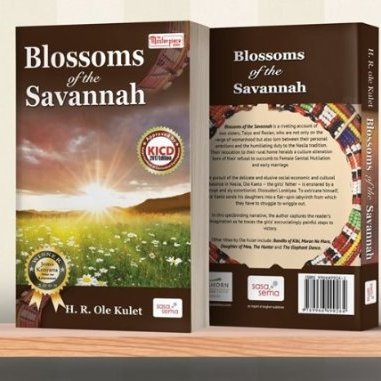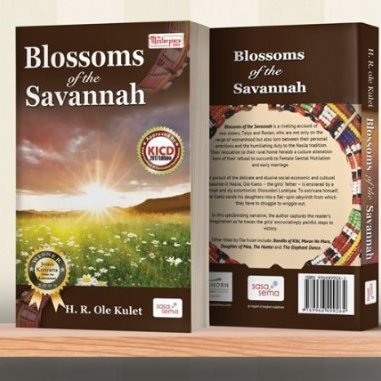Blossoms of the Savannah by Henry Ole Kulet is a riveting tale of how the determined daughters of Ole Kaelo Resian and Taiyo manage outwit the marauding cultural fanatics who stand on their way to joining University.
Set in Maasai land , with its setting alternating from Nakuru to Nasila where major actions unfold, Henry Ole Kulet’s “Blossoms of the Savannah” is an epic tale of how the two daughters of Ole Kaelo, Resian and Taiyo resist the brutal and barbaric culture that demonizes women in an extremely patriarchal system.
The title “Blossoms of the Savannah” could be relevant literally or metaphorically. In the literal sense Minik ene Nkoitoi, the Emakererei has her farm blossoming with flowers and tree despite being located in an arid area. At a higher level though, these flowers and trees in Minik’s farm would represent the flourishing of the many girls she rescued despite opposition from cultural fanatics like Ole Supeyo who regard her as a wasp.
Metaphorically the title represents the two daughters of Ole Kaelo who had a dream of joining Egerton University and despite opposition from their father who wanted to marry them off to Oloisudori, a man of immense wealth who got it through questionable means.
The two, Resian and Taiyo through wild determination resist the barbaric culture of early and forced marriages as well as Female genital mutilation which seeks to convert them into docile and zombified Maa women who conform to the dictates of tradition without questioning. This is exemplified in the personage of Ole Kaelo whose greed which exceeds love for family is massaged by the extortionate Oloisudori further wreaking his family apart.
From the time the two are introduced to Nasila things change dramatically, and as the author puts it “Ole Kaelo changes very fast to become a Nasilian”. Ole Kaelo chooses to embrace the Maa culture in totality. The same is proven when he makes a grand re-entry to his cultural roots is marked by cultural engagements such as the ceremony to allow him back.
The twists of events unfold as Ole Kaelo suddenly calls on his daughters and wife Jane Milanoi to embrace Maa culture in totality. This comes with resistance from Resian and Taiyo. Jane Milanoi, Kaelo’s wife subserviently follows the disastrous commands Which subsequently leads to the agony when the parents lose their two daughters.
The resistance of Resian culminates in her refusal to take Oloisudori’s hand in marriage amid uproar from her father who insists that the bride price of five hundred thousands had been paid. This, her father and Oloisudori likens to the young one of a goat refusing to sulk milk from its mother as Oloisudori offers hope for a better and lavish life. Resian is used as a bait to attract financial favor just as Olanna is used by her father in a bid to bribe Chief Okonji, the Finance Minister in Chimamanda Ngozi Adichie’s “Half of a Yellow Sun”
The succeeding events unfold when Oloisudori’s offer to convince Resian backfires. The indefatigable lioness fighter confronts her dad who reprimands her to take up the decision of marrying Oloisudori, resists and runs away.
A camouflaged opportunistic Olarinkoi, whose hawk eyes targeted Resian sees an opportunity and grabs it, convincing her that he will take her to her role model, Minik ene Nkoitoi, the Emakererei. Resian gullibly accepts the offer and sits at the back of the pick-up only for her to be taken to Olarinkoi’s house in the middle of the night. Here she finds herself caught between a rock and a hard place. And when Olarinkoi commands her to cook which she faithfully refuses , he turns on her with the intention of raping her. She resists, bites his finger and manages to escape rape.
Olarinkoi metes violence on her, she is left in a naked state only to be attended to by Nabaru, a reformed FGM practitioner. His mother a seer organizes the translocation and his would be wife to Tanzania. This is to escape the powerful Oloisudori, whom she refers to in mean terms, a robber and a poacher.
Nabaru aids Resian by convincing a lorry driver to divert, and take them to Emakererei, the girl’s idol. The quest is successful, Resian is rescued from the forced marriage to Olarinkoi. Emakererei consoles her, gives her a house, a job and promises to take her to Egerton, the institution of her dreams.
Five days later, a cornered Taiyo is forcibly circumcised and Minik dispatches her driver to rescue ‘a faceless girl in Nasila’. On coming, she realizes that she is in fact Resian’s sister and Ole Kaelo’s daughter.
The two reunite and are later enrolled at Egerton University before which a party is held for them. It is interrupted by the pompous Oloisudori who demands to be given either Taiyo or Resian as he had paid bride price for both amid Minik’s warning. Resisting, Minik’s staff descend on Oloisudori’s expensive machines leaving behind a wreckage. Team Oloisudori flee giving Taiyo and Resian a free hand to join University.
The text is relevant in that it champions for morality and empowerment of the girlchild in a society where women have been relegated to the periphery of society and their opinion considered trivial. The text is relevant to teenage and adult readers since it’s they that make crucial decisions.






